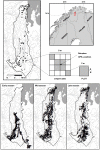Phenology and cover of plant growth forms predict herbivore habitat selection in a high latitude ecosystem
- PMID: 24972188
- PMCID: PMC4074057
- DOI: 10.1371/journal.pone.0100780
Phenology and cover of plant growth forms predict herbivore habitat selection in a high latitude ecosystem
Abstract
The spatial and temporal distribution of forage quality is among the most central factors affecting herbivore habitat selection. Yet, for high latitude areas, forage quantity has been found to be more important than quality. Studies on large ungulate foraging patterns are faced with methodological challenges in both assessing animal movements at the scale of forage distribution, and in assessing forage quality with relevant metrics. Here we use first-passage time analyses to assess how reindeer movements relate to forage quality and quantity measured as the phenology and cover of growth forms along reindeer tracks. The study was conducted in a high latitude ecosystem dominated by low-palatable growth forms. We found that the scale of reindeer movement was season dependent, with more extensive area use as the summer season advanced. Small-scale movement in the early season was related to selection for younger stages of phenology and for higher abundances of generally phenologically advanced palatable growth forms (grasses and deciduous shrubs). Also there was a clear selection for later phenological stages of the most dominant, yet generally phenologically slow and low-palatable growth form (evergreen shrubs). As the summer season advanced only quantity was important, with selection for higher quantities of one palatable growth form and avoidance of a low palatable growth form. We conclude that both forage quality and quantity are significant predictors to habitat selection by a large herbivore at high latitude. The early season selectivity reflected that among dominating low palatability growth forms there were palatable phenological stages and palatable growth forms available, causing herbivores to be selective in their habitat use. The diminishing selectivity and the increasing scale of movement as the season developed suggest a response by reindeer to homogenized forage availability of low quality.
Conflict of interest statement
Figures





Similar articles
-
Spring phenology drives range shifts in a migratory Arctic ungulate with key implications for the future.Glob Chang Biol. 2021 Oct;27(19):4546-4563. doi: 10.1111/gcb.15682. Epub 2021 Jul 12. Glob Chang Biol. 2021. PMID: 33993595 Free PMC article.
-
Forage quantity, quality and depletion as scale-dependent mechanisms driving habitat selection of a large browsing herbivore.J Anim Ecol. 2010 Jul;79(4):910-22. doi: 10.1111/j.1365-2656.2010.01701.x. Epub 2010 Apr 27. J Anim Ecol. 2010. PMID: 20443990
-
Habitat quality influences population distribution, individual space use and functional responses in habitat selection by a large herbivore.Oecologia. 2012 Jan;168(1):231-43. doi: 10.1007/s00442-011-2072-3. Epub 2011 Jul 16. Oecologia. 2012. PMID: 21766188 Free PMC article.
-
Plant phenological responses to experimental warming-A synthesis.Glob Chang Biol. 2021 Sep;27(17):4110-4124. doi: 10.1111/gcb.15685. Epub 2021 Jun 20. Glob Chang Biol. 2021. PMID: 33993588 Review.
-
Global grass (Poaceae) success underpinned by traits facilitating colonization, persistence and habitat transformation.Biol Rev Camb Philos Soc. 2018 May;93(2):1125-1144. doi: 10.1111/brv.12388. Epub 2017 Dec 12. Biol Rev Camb Philos Soc. 2018. PMID: 29230921 Review.
Cited by
-
Phenological Variations in the Content of Polyphenols and Triterpenoids in Epilobium angustifolium Herb Originating from Ukraine.Plants (Basel). 2023 Dec 31;13(1):120. doi: 10.3390/plants13010120. Plants (Basel). 2023. PMID: 38202428 Free PMC article.
-
Asynchronous vegetation phenology enhances winter body condition of a large mobile herbivore.Oecologia. 2015 Oct;179(2):377-91. doi: 10.1007/s00442-015-3348-9. Epub 2015 May 26. Oecologia. 2015. PMID: 26009244
-
Reindeer habitat use in relation to two small wind farms, during preconstruction, construction, and operation.Ecol Evol. 2017 Apr 21;7(11):3870-3882. doi: 10.1002/ece3.2941. eCollection 2017 Jun. Ecol Evol. 2017. PMID: 28616184 Free PMC article.
-
Human-induced environmental changes influence habitat use by an ungulate over the long term.Curr Zool. 2019 Apr;65(2):129-137. doi: 10.1093/cz/zoy035. Epub 2018 Apr 23. Curr Zool. 2019. PMID: 30936901 Free PMC article.
References
-
- Hanley TA (1997) A nutritional view of understanding and complexity in the problem of diet selection by deer (Cervidae). Oikos: 209–218.
-
- Manly BFJ, McDonald LL, Thomas D, McDonald TL, Erickson WP (2002) Resource selection by animals. Statistical design and analysis for field studies: Kluwer Academic Publishers.
-
- McArthur C (1993) Diet selection by a ruminant generalist browser in relation to plant chemistry. Canadian Journal of Zoology 71: 2236–2243.
-
- Trudell J, White RG (1981) The effect of forage structure and availability on food intake, biting rate, bite size and daily eating time of reindeer. Journal of Applied Ecology 18: 63–81.
-
- Skogland T (1984) Wild reindeer foraging-niche organisation. Holarctic Ecology 7: 345–379.
Publication types
MeSH terms
LinkOut - more resources
Full Text Sources
Other Literature Sources
Research Materials

